Although red symbolizes a range of emotions, such as love, courage, anger, and desire, the common denominator is that it signifies passion.
You must be passionate to love or be angry at something. Several elements in your surroundings evoke these feelings, including succulent plants.
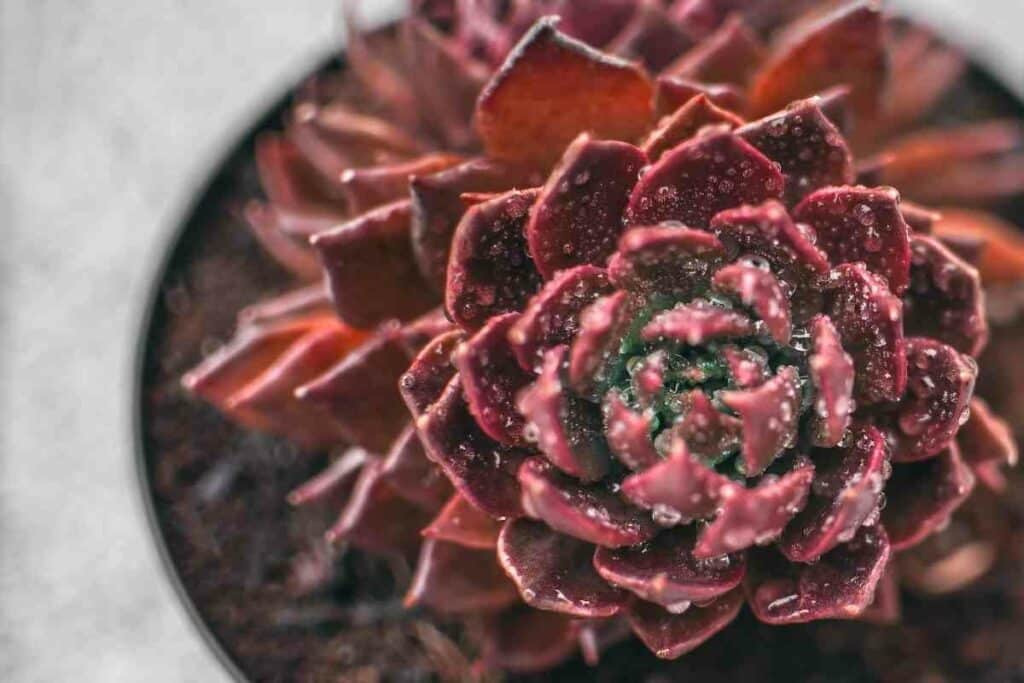
Growing red succulents in your garden makes it attractive and colorful. Likewise, these plants brighten and elevate the mood in your outdoor space.
What to Expect? Red is also a great gift that shows adoration to the recipient. Read on to discover more about succulents with red flowers and how they can beautify your home.
Types Of Succulents With Red Flowers
1. Flaming Katy Kalanchoe
The Flaming Katy Kalanchoe is arguably the most beautiful blooming succulent – this is a statement supported by many flower enthusiasts worldwide.
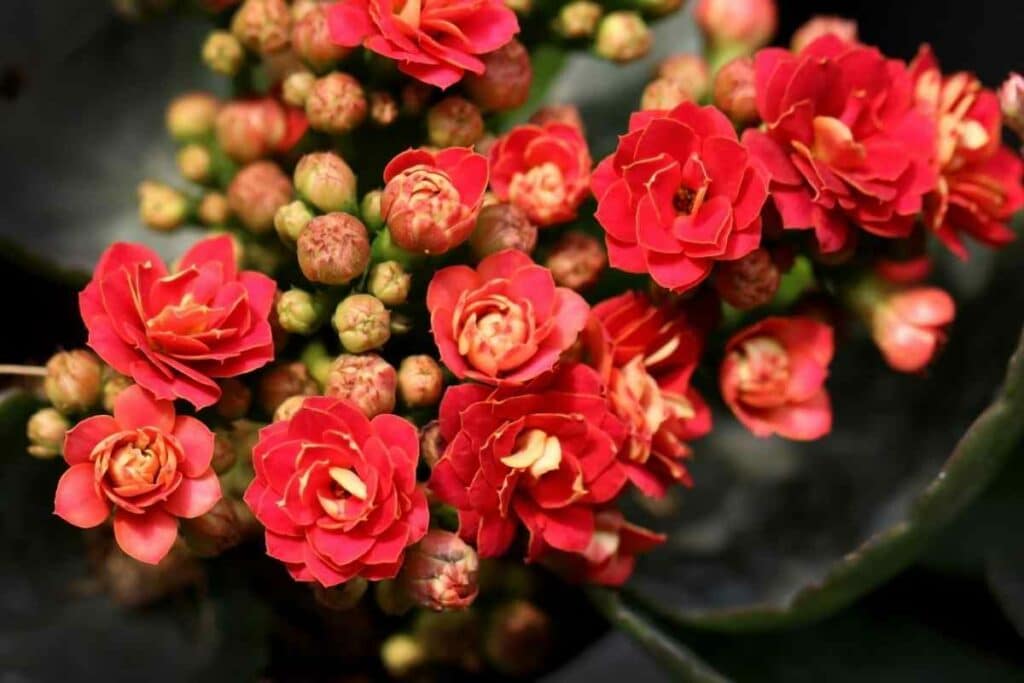
It gets its name from the flaming red blooms it produces in winter after reaching maturity.
This is the right plant if you want to brighten your bleak winters!
Besides its stunning looks, this plant produces a lot of flowers. It’s one of the most vibrant succulents with red flowers.
If you don’t know how this plant looks without flowers, it’s equally as eye-catching.
It has thick, waxy, lush green leaves with pretty edges that resemble the foliage of jade plants.
However, you shouldn’t let the plant bloom itself for the first time.
Doing so increases the risk of inconsistencies in the subsequent blooming cycles.
Action to Be Taken – If your plant is yet to bloom, move it to a dark spot until it produces its first flowers. The best time for this is at the onset of winter, usually towards the end of October.
2. Barrel Cactus
Barrel cacti are the perfect red succulent for outdoor gardens.
Their vibrancy can add liveliness to an otherwise dull backyard.
The plants thrive in warm climatic conditions, such as in the southern states like Texas and Florida.
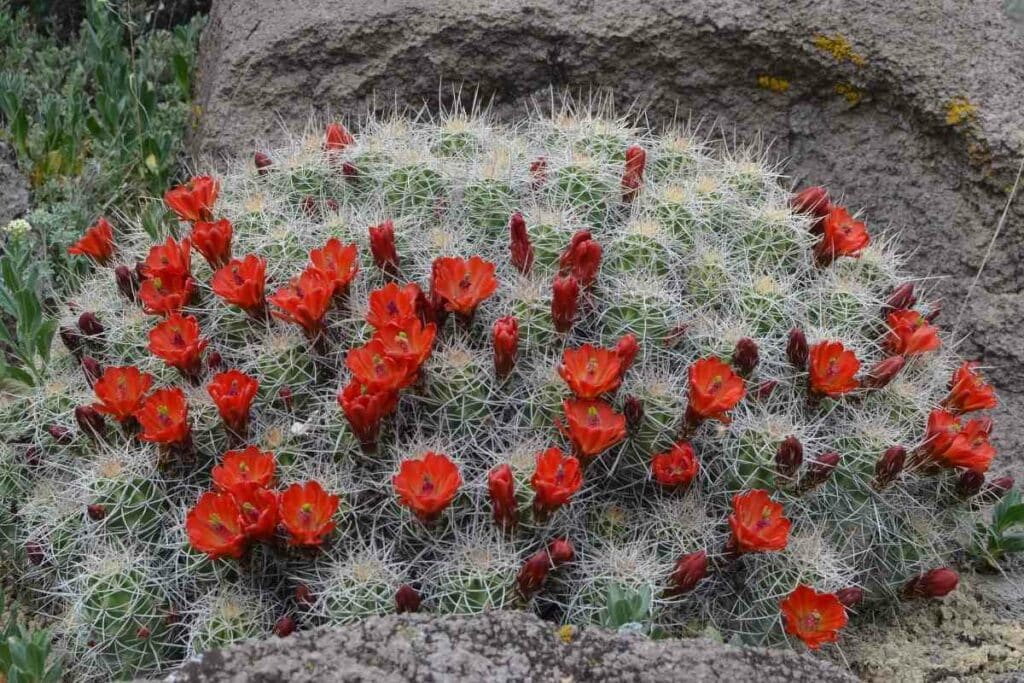
You can also grow Barrel Cactus indoors, provided your home receives adequate sunlight.
Otherwise, you must install artificial grow lights.
Upon maturity, Barrel Cactus assumes a cylindrical shape, from which it gets its name. The annual plant blooms in the early months of summer.
Barrel cacti flourish in soil with proper drainage. If you decide to pot the plant, ensure that you use a well-draining growth medium to avoid complications.
Like other cacti, Barrel Cactus is relatively hardy. However, watering it at least once weekly during summer and late spring is essential.
If your area receives a good amount of rain, you won’t have to worry about watering.
In Winter – Barrel Cactus becomes dormant. The plant restricts its nutrient absorption to support necessary functions. This is an adaptation that sees it through the harsh conditions.
Overall, the Barrel Cactus is a combination of beauty and hardiness. If you take proper care of it, it can last until your kids are in their teens! Moreover, it’s a consistent bloomer.
3. Christmas Cactus
The Christmas Cactus is so-called because it produces flowers towards the end of the year.
It’s a huge family of succulents that gives off a range of colorful blooms, including stunning red flowers. These blooms usually last for up to eight weeks.
Unlike other cacti, the Christmas Cactus isn’t native to arid regions. It originates from Brazil, which experiences a tropical climate.
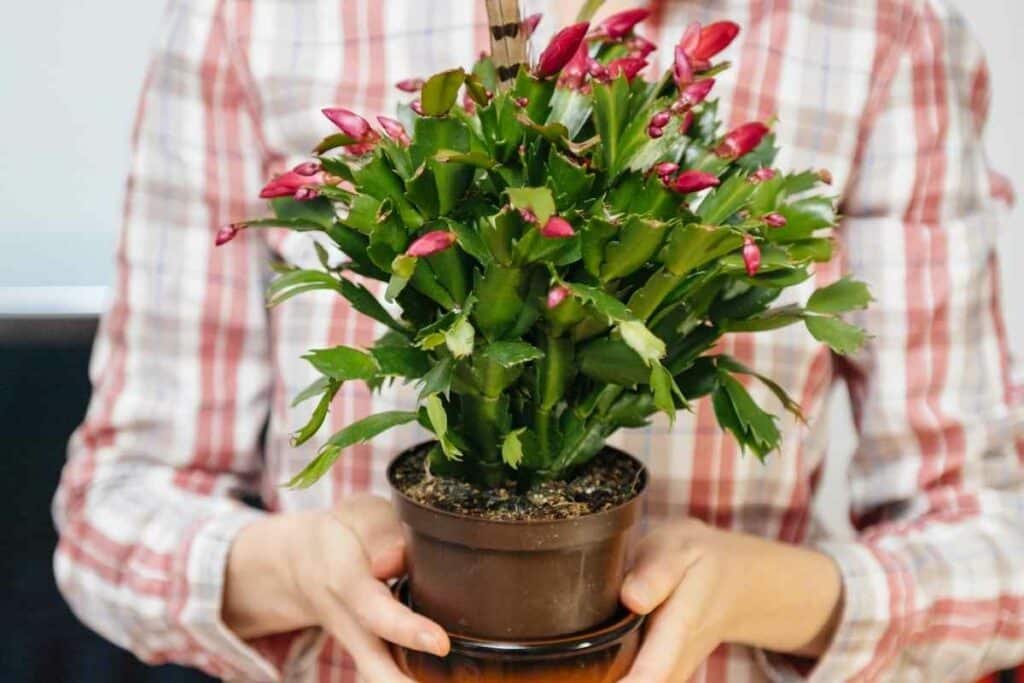
This explains why it thrives in moist and humid conditions.
You must water your Christmas Cactus if you want flowers. In spring and summer, the recommended watering frequency is once weekly.
During fall and winter, it’s advisable to water the plants less often, preferably once every two weeks.
Additionally, Christmas cacti need dark environments to bloom. Ensure that you keep these succulents for up to 14 hours to promote budding.
If you live in hot areas that experience temperatures above 55oF, your plants will need an additional two hours to bloom successfully.
In mid-October – Towards the start of winter, you must reduce your watering frequency and exposure to sunlight. Your plants should start budding six to eight weeks into this period. When this happens, return them to a sunny spot and wait for the blooms to emerge.
4. Euphoria Milii
Euphoria Milii, a native of the East African island of Madagascar, is a red succulent known for its gorgeous little flowers that resemble buttons atop its foliage.
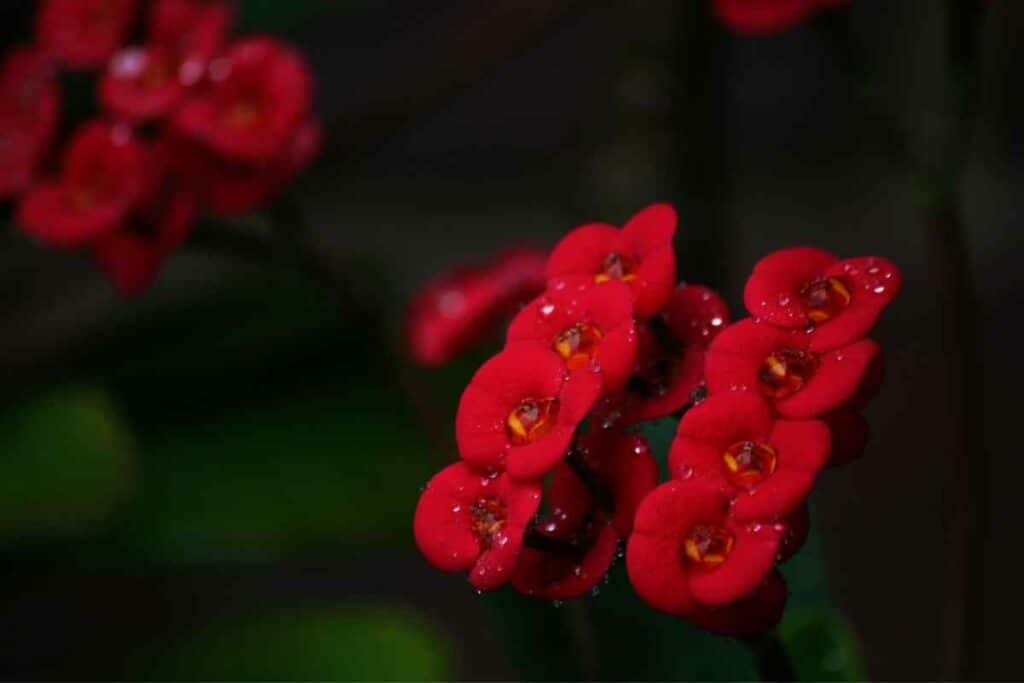
It is also called the Crown of Thorns.
Being a tropical succulent, it can withstand the hot conditions experienced in Nevada, New Mexico, Texas, etc.
If you live in the cold north, this plant can only survive in indoor gardens.
For Optimal Blooming – You must grow this plant in an area that gets a lot of sunlight. You can grow it outdoors or on a windowsill in a spot that receives plenty of solar radiation to get the most colorful red flowers.
Otherwise, you might want to consider getting grow lights.
5. Torch Aloe
As the name suggests, the Torch Aloe is related to Aloe Vera, a plant famous for its medicinal value.
However, it’s brighter than its visually uninteresting cousin, as it has attractive orange-red blooms that emerge in winter.
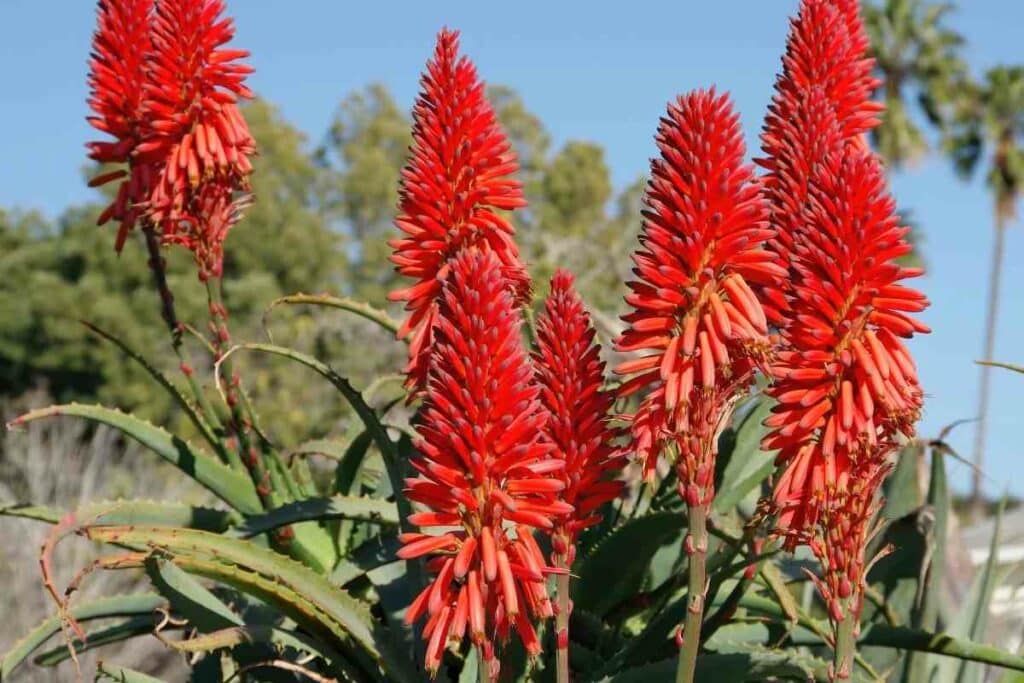
The Torch Aloe is a hardy plant with distinctive sword-shaped leaves and striking conical flowers.
In ideal conditions, it reaches up to ten feet tall. Its medium size makes it perfect for indoor and outdoor decoration.
If you want to plant it outdoors, ensure that your garden has well-draining and fertile soil. Otherwise, invest in a high-quality potting mix to grow it indoors.
The Torch Aloe thrives under sunny conditions, but it can tolerate some shade. However, saturated soil is a no – it increases the risk of root rot and leaches crucial nutrients.
Don’t Forget – Always dilute your fertilizer before applying it to this plant. As the plant approaches its blooming cycle, reducing or cutting off nitrogenous fertilizers hinders flower production and promotes vegetative growth.
6. Huernia Zebrina (Lifesaver Plant)
Are you looking for a shapely and visually stunning red succulent?
Then, look no further than Huernia Zebrina, also called the Lifesaver Plant.
A native of southern Africa, this succulent flourishes in sunny and warm environments.
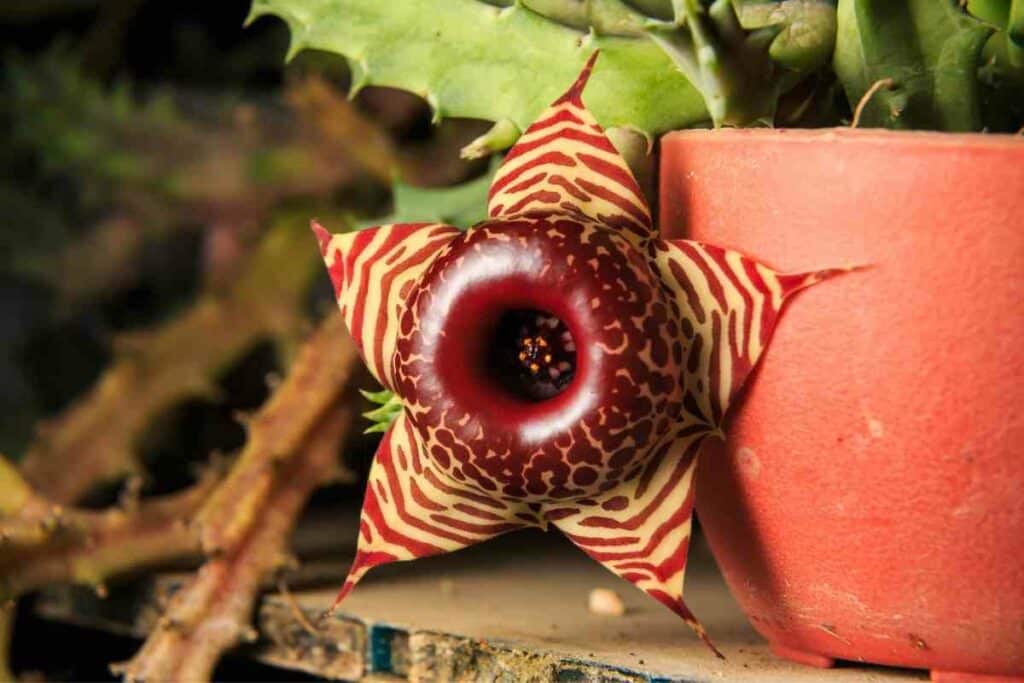
The Lifesaver Plant has light-colored petals with a few stripes on the corolla. The flower’s middle has a red soft-textured ring known as the annulus.
Additionally, this plant needs staking because it’s a creeper. The best thing is that this plant doesn’t require a green thumb.
You only need a well-draining growth medium to plant it indoors. If you have a garden, a sunny spot is enough to make it bloom.
7. Sempervivum Tectorum
Sempervivum Tectorum, also called Hens and Chicks, is an attractive succulent with red flowers that grows indoors and outdoors.
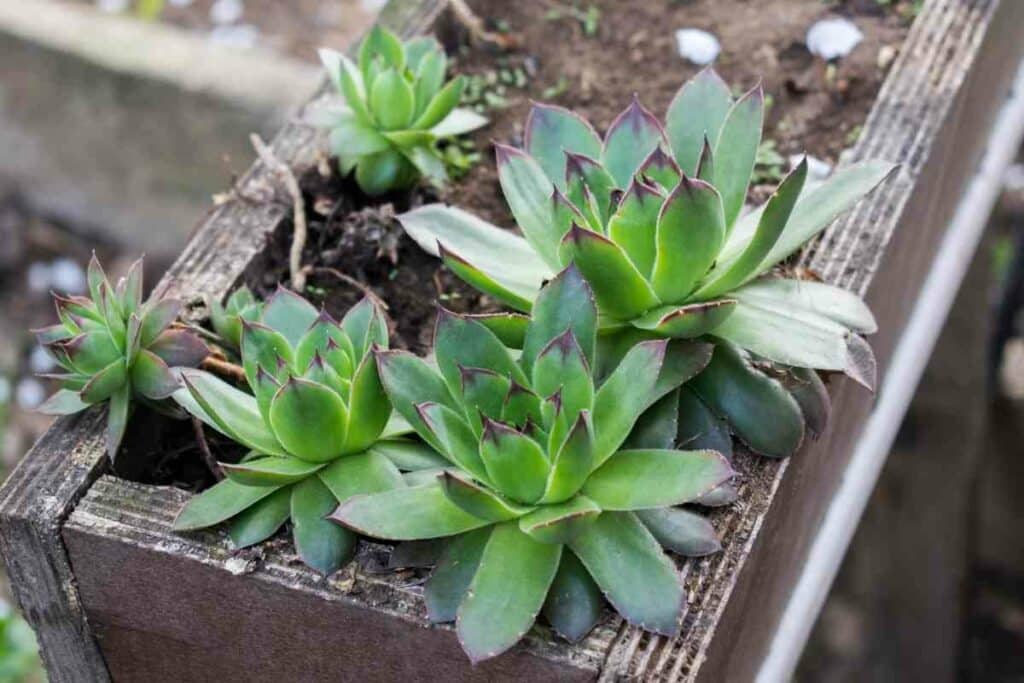
The plant’s blooms look like rose flowers, although they aren’t as glorious.
Its nickname originates from the tiny offsets produced by parent rosettes, where the parents are Hens, and the offsets are Chicks.
In Latin: Sempervivum Tectorum means Live Forever. The plant is so-called because it produces offsets continuously throughout its lifetime, creating a sense of perpetuity.
8. Baby Sun Rose
Baby Sun Rose is a small succulent plant that can hugely impact your overall décor, whether indoors or outdoors.
It’s also called Aptenia cordifolia and has lush green and tiny foliage that blooms small red flowers in late spring and early summer.
It’s amazing that the flowers open up in the afternoon and close in the evening.
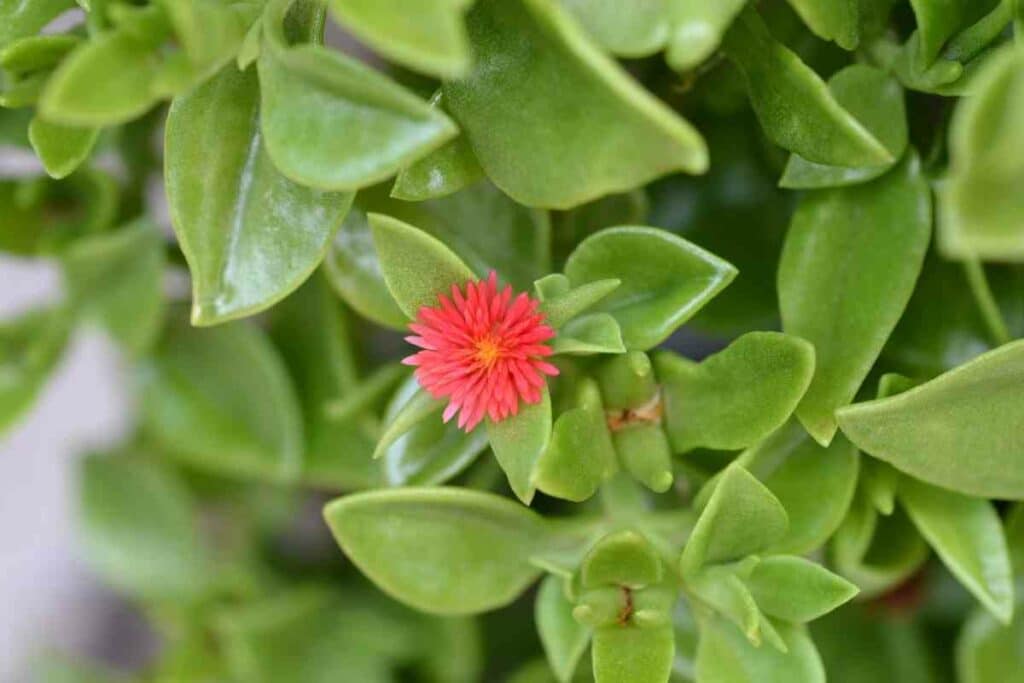
A fully-grown Baby Sun Rose measures six inches tall. However, this plant can cover up to two feet horizontally under the right growing conditions.
Because of their tiny size, Baby Sun Roses are a great addition to your hanging floral arrangements.
When you grow them in pots, ensure that the soil is well-draining, and more importantly, the container has drainage holes.
Please avoid saturating the soil or potting mix, as this increases the risk of root rot. Let the soil dry before adding more water.
As for Nutrients – Use diluted water-based feeds or slow-release fertilizer every six months.
9. Burro’s Tail
Burro’s Tail is a somewhat confusing plant – while some people think it doesn’t bloom, it produces stunning red flowers in summer.

Even so, it blooms inconsistently.
If you want your succulent to produce flowers, you must provide plenty of sunlight.
This means that it isn’t easy to grow indoors, as the growing area must have no shade.
Fortunately, Burro’s Tail plants are attractive, even without flowers. It has long pale green trailing stems and fragile tendrils.
10. Echeveria Black Prince
Most people grow the Echeveria Black Prince due to its beautiful leaves, which come in several colors like:
- deep purple
- dark brown
- and black
As such, its red flowers are a bonus to what is an already visually attractive succulent.

Like Sempervivum Tectorum, this succulent produces rosettes. In areas that experience mild climates, the Echeveria Black Prince blooms in winter.
Where winters are extreme, the flowers emerge in early spring.
Lastly – The Echeveria Black Prince is a favorite of many pollinators. You might want to grow it if you like watching birds at close range.
Wrapping Up
Red is a powerful color, whether you consider it auspicious or portentous.
Its intensity can make a dull moment lively, and its boldness showcases power and courage.
If you’re going for pure beauty, nothing beats the Flaming Katy Kalanchoe.
The Barrel Cactus is an excellent pick if you have a black thumb. Otherwise, you’ll be good with the other choices on this list. Good luck with your planting!


